PPC data is not the new kid on the block; it’s an old acquaintance, someone you’ve known for a long time but you never said hi. It’s time for a change. Get to know it and make it your best buddy.
It’s no secret that you think metrics aren’t appealing. Most of the people think just the same. But they are of paramount importance for your business. And you’ll find out how to make the most of it using the PPC data in your SEO strategy to get that high ranking you’ve always been keen on having. Are you thirsty? Follow the steps and get the link juice.

We’ve put together a full guide to help you find out how to use PPC data to get more SEO traffic. As PPC campaigns can impact SEO very much, you shouldn’t think in terms of SEO vs PPC but you should look at SEO and PPC altogether, as combined they can be traffic and conversions generators. Below you’ll lay your hand on the meaning of each element, PCC data, and SEO traffic, then you find out the connection for a winning SEO strategy and, in the end, about the most valuable SEO metrics and data.
- In the Days of Yore: What Are PPC Data and SEO Traffic?
- How to Use PPC Data to Guide You Towards a Winning SEO Strategy
- Step 1: Pull out PPC Data to Find out Your Best Performing Landing Pages
- Step 2: Compare Google Console Data to PPC Data
- Step 3: Plan and Implement Your SEO Strategy
- How to Pull out Valuable PPC Data From Google AdWords
- Click-Through-Rate (CTR)
- Conversions
- Impressions
- Bounce rate
1. In the Days of Yore: What Are PPC Data and SEO Traffic?
The term PPC data may be hard to understand, and it may be hard to get an exact definition in a digital marketing perspective because it embraces a broader knowledge. Before we start to cut the information into pieces and dig into it, we must bring to light the PPC acronym.
A quick search on the Internet will not give you all the details you need to know about PPC. Try it for yourself; just google PPC and you will be delivered with all sort of data from PPC medical abbreviations (Physician Practice Connections, Prescription Prepayment Certificate, Plasma Protein Concentration, Posterior Parietal Cortex) to PPC accounting data (Practitioners Publishing Company). Not to mention that PPC is the acronym for various companies in the world. If the company is famous, it can offer authority to a specific term. That’s how PPC stock got to be a popular search query in the Google search engine. Pilgrim’s Pride Corporation (PPC) is currently the largest chicken producer in the United States Puerto Rico. There are many more PPC acronyms meanings, but we will not go deeper into that now.
Yet, neither chickens nor medical supplies are our field of interest for the moment.
If we talk about PPC marketing, we think of pay per click, which is a model of paid advertising and does what the name says. The advertisers pay a fee for each time their ad is clicked.
Going back to our question: “What is PPC data?”
PPC data is pay-per-click data, and it refers to the information extracted from a paid search marketing campaign.
And yet, how can you connect PPC data with SEO traffic in order to get a winning strategy for your organic traffic?
As we need to clarify terminology first, we start with a question: What is SEO traffic?
SEO (Search Engine Optimization), per se, is a process of getting traffic in an organic manner. SEO brings together an umbrella of terms that are important for ranking higher and higher in SERPs (links, content marketing, social media, etc.) In order to be a real PPC hero you need to be a master of data analysis but also to use all this data for SEO traffic increase. At the end of the day, this is the main objective.
We all know the saying “content is king”. It has been rolling out for quite some time now, that it started to get annoying, but there is something that comes after that. It needs a completion for the time being.
If content is king, then the user is queen, and she rules the universe. – Cyrus Shepard
With the right mindset, people, strategy, tools and other resources, you can receive inbound links and grow your website. You will then improve your ranking, see hikes in traffic site and increase revenue. Mastering the PPC data, on the other hand, can give you an enormous competitive advantage when it comes to SEO traffic.
SEO traffic is a long debated subject, a hot topic. The fact is that search is a blood sport. Search has changed a lot, so has paid search advertising, cost per click or pay per click. Remember that not long ago we had ads from Google AdWords on the right side of desktop search results? We have Google’s knowledge boxes nowadays. You must play smart.
There are multiple ways and successful stories you can follow to bring the results you want and increase SEO traffic, but today we’ll talk about the power of PPC data for that.
2. How to Use PPC Data to Guide You Towards a Winning SEO Strategy
We must bring into question the types of search, which can be divided into paid and organic so we can fully understand the connection of SEO traffic and PPC data. We use these two in online marketing because on a higher level the aim is to generate sales.
Organic search marketing stays under the umbrella of SEO and paid search marketing is his twin brother, named SEM. While SEO means, in short, quality content and quality links, SEM includes on a wider perspective of PPC marketing, which is the smartest paid search marketing campaigns. There are various campaigns/activities included, such as:
- paid search ads;
- display search ads;
- shopping ads;
- video ads;
- ads for mobile app.
One of the most used online advertising platform to create PPC campaigns is Google Adwords. The tool is complex and offers the possibility to create the campaigns mentioned above.
On a general meaning, Google AdWords offers advertisers the setting to bid on certain keywords in order for their ad to appear on Google’s search result page. An advertiser (agency) or business can make an account on AdWords and start campaigns, create ads and upload a list of keywords.
On a granular level, there are different steps for each type of campaign mentioned above.
Let’s get down to business and find out how to use PPC data to get more SEO traffic. Now or never! There are a few steps you need to follow. Now comes the interesting part.
You can’t use only Google Adwords, you should use it together with Google Analytics to get the full picture. That’s how a smart SEO strategy works. And let’s see how to use PPC data to increase SEO traffic.
Step 1: Pull out PPC Data to Find out Your Best Performing Landing Pages
You have to log into your Adwords account. Click on the campaign you want to analyze and then go to the keywords tab. Here you have the possibility to customize your tab to see the keyword data before you download the report and compare PCC data with organic queries. For that, you need to click on the Columns button and select final URL from Attributes list. You can see all the steps below:
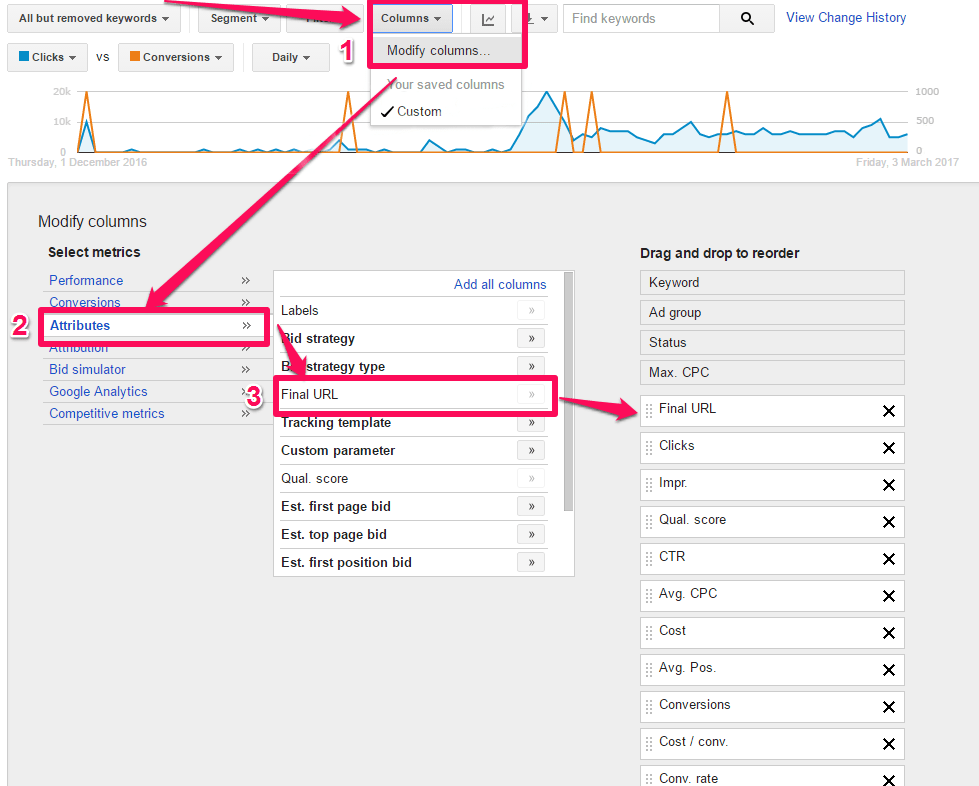
After you click Apply, you will have the next table with your Adwords data. Now you can download the report.
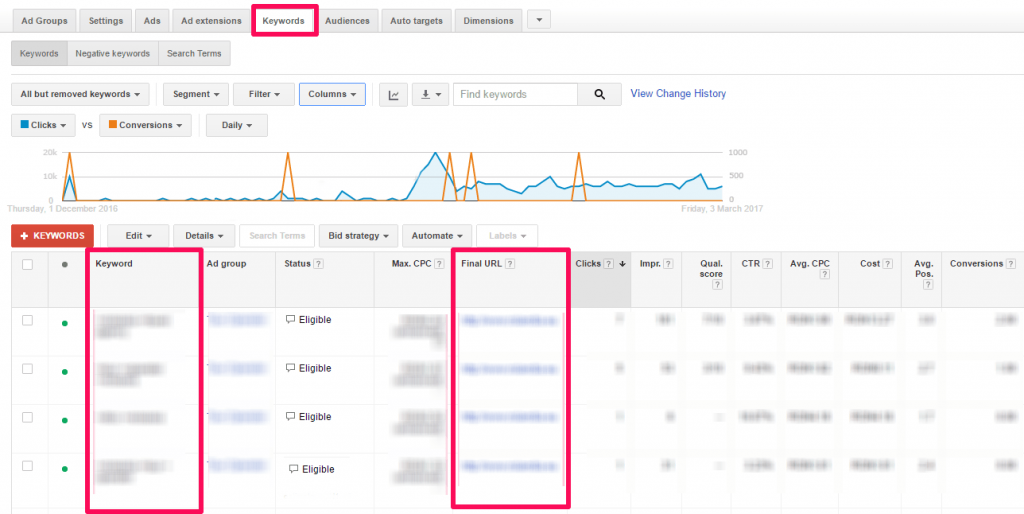
You can easily download this report from your Analytics account, too. You have to log in and then from the Dashboard click Acquisition > Adwords > Destination URLs. Then set your second dimension Keyword to see the best performing landing pages and keywords. You can choose to sort the list by any metric you want. After that, you can export the list and see the best 30 landing pages.
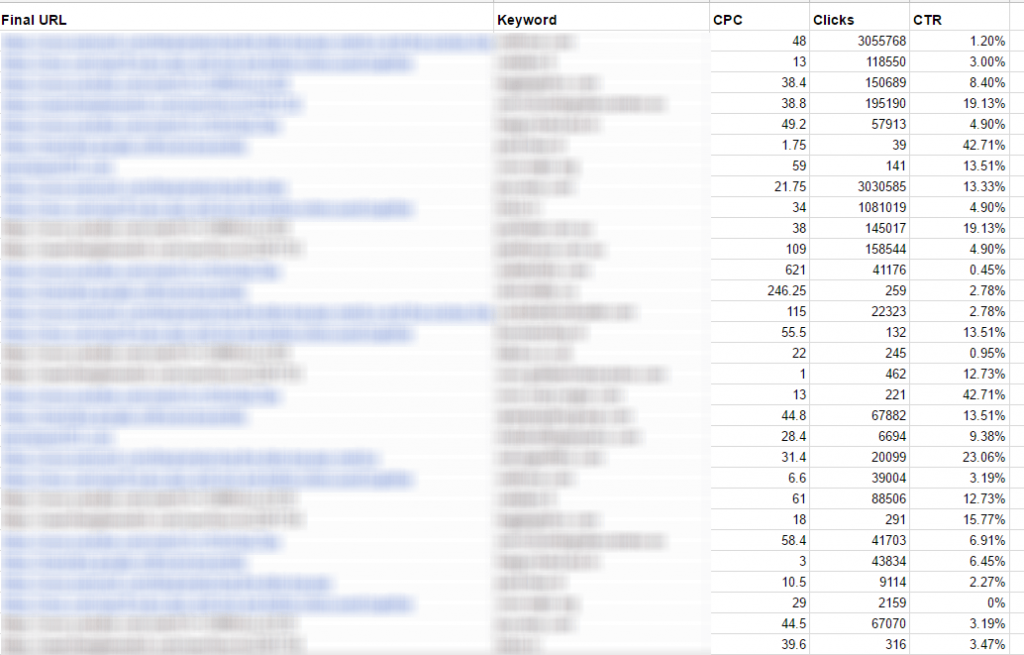
It is important to know that this works best for enterprises and big agencies because they have larger campaigns and lots of landing pages. If you have a small company, you might see a smaller amount of landing pages, and this approach might not lead to notifiable results.
In this case, you should analyze the best 30 performing keywords for the landing pages you added on Adwords and then go to the next step.
Step 2: Compare Google Console Data to PPC Data
For this step you have to go in Analytics to Dashboard and Acquisition > Search Console (Google Webmaster Tool) > Queries and download the search data. Queries are the organic search keywords that get users on your website. Make sure you select the largest range (for example 90 days) to get the full picture. You can see the picture below to get the report.
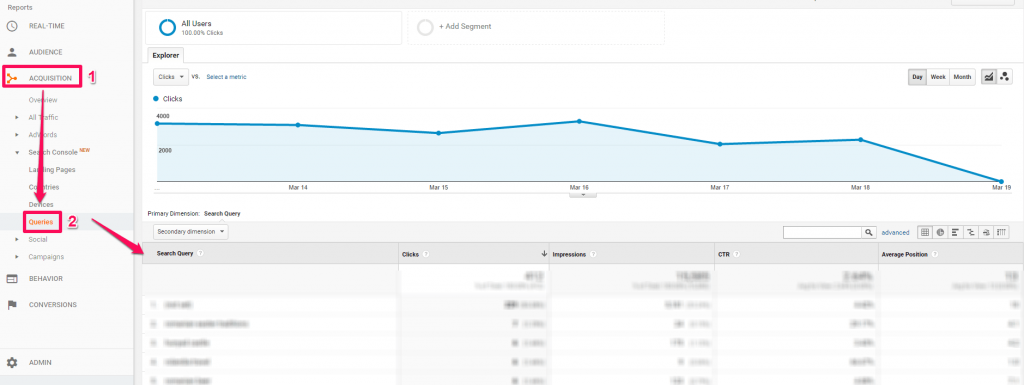
Use a single Excel by combining the data from both your reports into different sheets. Then use the VLOOKUP function in Excel to pull in ranking data into the spreadsheet containing the top PPC landing page/keyword combinations. Look for each of your keywords in the queries table for an approximate match.
Step 3: Plan and Implement Your SEO Strategy
Now you see where your site shows up in organic for the top PPC keyword/landing URL combinations. Now that you have the metrics, you need to make the analysis. When you’re ready, plan and implement your SEO strategy.
One strategy will be to check if PPC and organic landing pages are the same. Another one would be to filter the data by Average Position to see only the first rankings. You can also use PPC terms based on conversion and create new content around them. Make sure you place the keyword in the title tags, headline tags, meta description, content, image descriptions and so on.
4. How to Pull out Valuable PPC Data From Google AdWords
PPC data is a valuable asset for setting your KPIs. There are numerous metrics that you should take into consideration, but we’ll talk about the ones you couldn’t live without.
4.1 Click-Through-Rate (CTR)
CTR is an important metric to track in all of your PPC advertising campaigns. The click through rate measures how many of the people who saw your ad click on it. In Google AdWords, you can find it on the campaign, ad and keyword level as you can see in the next screenshot.
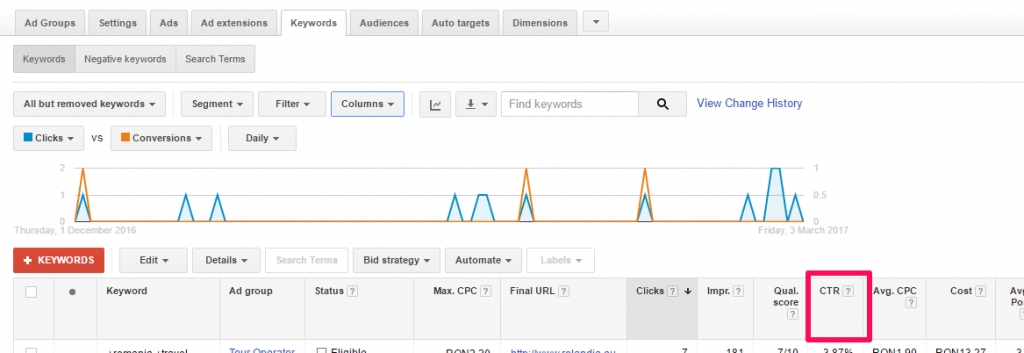
In an ideal world, you’d want a high CTR because it is a sign of authority and shows your ad is performing well. But it is important to analyze this metric together with the conversion rate. The conversion rate shows the number of conversions per click (ad interactions). This metric gives you the chance to maximize every cent of your PPC by finding the best performing ads.
Having a high CTR and low Conversion Rate means your ad might have a problem. The CTR shows your copy is creating interactions, but the landing page might not fulfill the needs of your prospects or it doesn’t deliver the promise from the ad copy.
Having a low CTR and high Conversion Rate means that your ad might not be appealing enough. If you have low CTR and low Conversion Rate, there is a serious problem. Looking for these metrics can guide you into finding ads that see high results and discover keywords that could help you rank higher in the organic search.
4.2 Conversions
If you have PPC ads, it is recommended to keep an eye on the number of conversions. A conversion in Adwords is known to happen when a user clicks on the ad and takes action on the site. The type of the action depends on the type of conversion you’ve set up, placing products in the shopping cart, submitting a request for more information, clicking a call extension, sending a query, booking something and so on.
Beside this clean conversion, where you know the path, there are other two types of conversion. View-Through Conversion occurs when the user sees your ad, doesn’t click on it, but later on finds your website organically and converts. Assisted Conversions happen when the user interacts with the ad, enters your site, then leaves and comes back organically on the site and converts.
4.3 Impressions
An impression is counted each time your ad is being seen. It is desired to have keywords with lots of impressions, because they are likely to trigger other favorable results, at least in theory. Having lots of impressions doesn’t cost you a penny.
4.4 Bounce Rate
Bounce Rate is the percentage of single-page visits or visits in which the person left your site from the entrance (landing) page. It is good to track this metric because you can find out if there’s something broken on your site:
- 25% or lower: Something is probably broken;
- 26-40%: Excellent;
- 41-55%: Average;
- 56-70%: Higher than normal, but could make sense depending on the website;
- 70% or higher: Bad and/or something is probably broken.
Beside the metrics mentioned above, there is another one worth mentioning – the quality score, which exists exclusively in Google Adwords. A score out of 10 is shown for each keyword. The higher the number, the higher the chance to lead to lower prices and better ad positions.
The cherry on the top is the Keyword Planner Tool that you’ll find in Adwords. It is a keyword research tool that offers a real guidance into finding the most suited keyword for a new piece of content. You can use it by looking at the average monthly searches and the competition. Copywriters used often in their content marketing strategies to get the best-suited keyword and phrase before submitting into writing a new piece of content. It is really used in the digital marketing area. Not to mention it can be really helpful to use this PPC tool to increase SEO traffic.
Now more than ever, it would be great to have an AdWords account because this tool has proven to be an excellent support along the time. Particularly, I’m saying that because, since June 2016, you can’t access the Keyword Planner tool if you don’t have an active AdWords campaign running.
For example, look at a print screen for a search on “newsletter template” using an account with no active campaign:

And this is a print screen for the same term using an account with an active campaign:
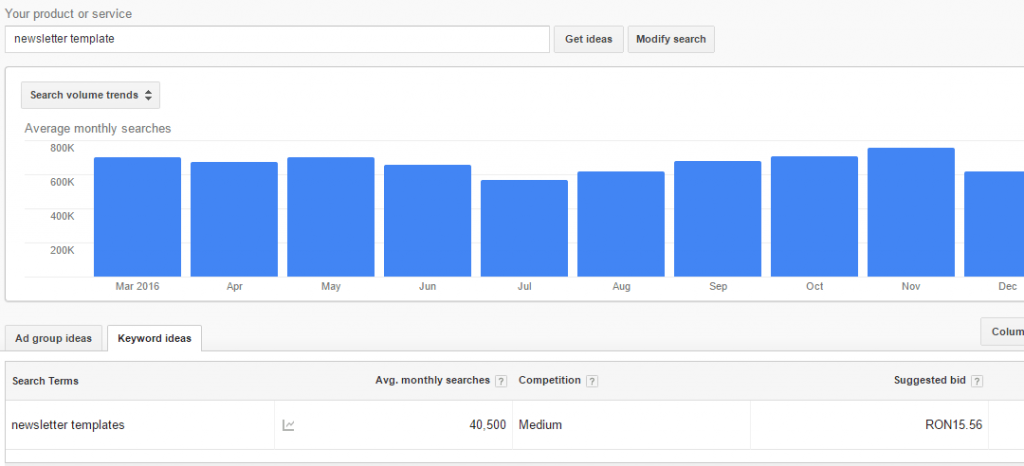
You can see that the data is more accurate for those who pay.
Conclusion
Nowadays, you must know that page-level tracking is more important than ever. You haven’t heard the discussion about SEO on a granular level just once. Here it comes again. Now dragging SEM after it. PPC data is on the map, and you must be smart in order to get a strategy that is effective. Combining data and finding the right formula is hard, it may take you some time if you’re a stranger to AdWords, but this way you can find out some opportunities you didn’t take into consideration. And that’s loss in ranking higher.
Search Engine Optimisation should be the simple activity of ensuring a website can be easily found in search engines for specific words and phrases relevant to what the site is offering. Pay-per-click (PPC), also known as cost per click (CPC), is an advertising model used to direct traffic to websites. Therefore both SEO and PPC have the same purpose: driving traffic while making your website known to the user.
Whether they are paid search results or organic results, when you log into your Google Analytics account what you want to see is your business growing. You want to see that all your SEO efforts, weren’t in vain, regardless if it’s keyword research you are working on, inbound marketing, social media, link building or paid ads. Use the PPC data along with the organic queries and create an efficient SEO strategy.

 Site Explorer
Site Explorer Keyword tool
Keyword tool Google Algorithm Changes
Google Algorithm Changes

I guess this works because it lets you test drive the traffic through PPC ads. From there, you can learn more about the type of market that is attracted to your blog and you can focus your SEO efforts there.
I have nothing populating in my Final URL column. I place the landing page for final URL as I’m creating my ad. Do I need to take an extra step in order for the final URL to populate in the keyword tab?
Hi Peter,
You don’t need to take an extra step. There are cases when the URL appears, and there are cases when it doesn’t.
One very important detail is that a SEO optimised landing page will cost less in Adwords because it will increase the quality score of your Adwords keyword.
So I advise you do at least a little SEO effort before doing Adwords;
Thank you for sharing the information…
Yeah, CTR(Click through rate) is beneficial for creating an ad on PPC because it tells much more about the audience that a single ad gets how many clicks?
This is also useful for making the content engagement.